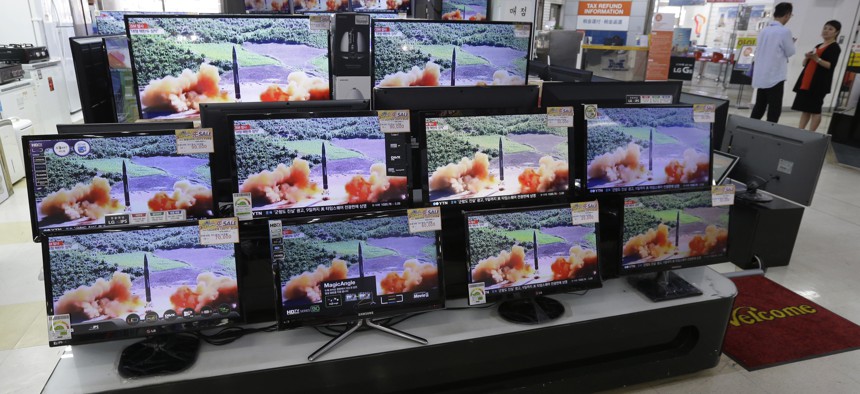
TV screens in an electronics shop display a news program's report on North Korea's missile firing in Seoul, South Korea, Thursday, July 6, 2017. Ahn Young-joon/AP
The Pentagon is Funding Silicon Valley’s Space Industry to Watch North Korean Missiles
The U.S. military doesn’t have the information it needs to stop an attack by North Korea. But officials believe they know where to get it.
The US doesn’t have the information it needs to stop an attack by North Korea. But it knows where to get it, thanks to a small unit within the Department of Defense that works like a Silicon Valley investment firm.
North Korea’s recent ICBM test has analysts convinced that it can strike the US, possibly with a nuclear weapon. The US can’t reliably spot missiles before they launch, and North Korea’s use of mobile launchers makes it even harder. Spotting these mobile launchers in a timely fashion could allow the US to launch preemptive strikes, a plan known as “Kill Chain,” or evacuate threatened cities in time.
The only way to guarantee this kind of vision is to use space-based radar systems with enough satellites to provide blanket surveillance of the Korean peninsula. Satellites that take visual images can be confounded by the weather, and radar from planes and ground stations lacks the range and consistency.
The problem has always been money. In 2007, the Congressional Budget Office evaluated the costs (pdf) of various space radar systems with observing North Korea in mind. The cheapest option weighed in at $27 billion; the most expensive, $94 billion. Predictably, lawmakers refused.
But imminent threats tend to focus the congressional mind. Andrew Hunter, a senior fellow at the Center for Strategic and International Studies, who has worked in defense procurement at the Pentagon and in Congress, recalls that when troops in Iraq started falling victim to improvised explosive devices, “Congress and the Defense Department’s leadership said, ‘Oh yeah, we’re willing to spend tens of billions of dollars to protect our troops from this threat.’ Five years before, the decision was not to devote any resources to meet this threat. People were aware that it was out there; what changed was their understanding of the odds that of it happening. The odds of North Korean launch against the United States are much higher than we would like them be.”
On a traditional satellite procurement schedule, it could take five years to get the birds in orbit if the money were approved now. But a vibrant new space industry is springing up as trends in cheap, powerful electronics and batteries converge with ambitious business plans funded by US venture capitalists.
Non-governmental organizations have already used commercial satellite data from companies like Planet to monitor North Korea’s weapons programs. Planet launched its first test satellites in 2013; today, it operates 190 satellites, the largest commercial constellation in the world, and is well on the way to imaging the entire earth daily.
Tapping into this zeitgeist to surveil North Korea is the job of the “Defense Innovation Unit, Experimental,” or DIUx.
Read more: DIUx Wins Support — and More Cash — from Trump’s Pentagon
See also: Spooked by North Korea, Lawmakers Resurrect an Old Missile-Defense Idea
Don't Miss: Give Up on Denuclearizing North Korea
The organization isn’t quite a government-backed venture capitalist (that’s In-Q-Tel, the CIA’s venture-capital arm) but more like a friendly face for entrepreneurs with exciting technology who are daunted by the thicket of rules and regulations that come with working with the federal government. The office of about 50 staff concludes development contracts with young companies, giving them funding in exchange for their work on new technology, with the possibility for a full-fledged contract down the line. The model is similar to the public-private partnerships NASA used to fund SpaceX and OrbitalATK.
To tackle the North Korean threat, DIUx began by contracting with Orbital Insight in February 2017. The start-up, which is dedicated to turning advances in machine learning to the massive and growing accumulation of satellite imagery, will build tools for the government that can analyze images in real time.
Then, in March, DIUx signed a contract with Capella Space, which was founded by former government engineers, to develop a constellation of small radar satellites. These will use Synthetic Aperture Radar or SAR, which builds up high-resolution images by making repeated passes over the same spot. Capella’s CEO, Payam Banazadeh, told me in January that he expected to launch the first satellite of an expected 30 this year.
“Some very, very smart people that we respect highly in a variety of branches of the Department of Defense and intelligence community concluded that a) Capella’s technology was superior to anything on the market or that would be in the market and that b) it was ideal for that impressive technology to be operational in as many satellites as possible, as soon as possible,” says Matt Ocko, a partner at DCVC, Capella’s primary financial backer. Capella, like most earth-imaging companies, already envisioned doing business with the government, and Ocko says the DIUx contract accelerated these plans.
All this makes DIUx’s sequence of investments look a lot like the journey down the value chain we’ve seen Silicon Valley investors follow. It invested first in a software company working to better analyze existing satellite data. That led it to a satellite operator with plans to gather better, more frequent, or different data. In turn, that will lead it to work on improving the satellite launch business: Its next investment will be in a US company developing “a new breed of launch vehicles that are purpose built to deliver smaller payloads at a much smaller cost,” said a Defense Department spokesman in a statement.
Which company might that be? There are only a few obvious candidates. One, Vector Space, raised $25 million in a July investment round to develop its small rocket after a successful test flight earlier this summer. The round was led by Sequoia, a venture-capital firm that is also an investor in Orbital Insight. Bill Coughran, a partner at Sequoia, says he thinks the government is “also seeing value in these near-earth-orbit kind of small satellites, as opposed to some of the mega-satellites they’ve traditionally deployed.”
Another potential target is Rocket Lab, a US-New Zealand small-rocket firm. It too had its first test launch this summer and raised more than $75 million this year in a round led by DCVC, the Capella Space funder. “You may notice that we are also investors in a space access company, able to launch on very short notice, very inexpensively,” Ocko says. “We are hopeful but not requiring that our companies make beautiful music together.”
There are concerns that DIUx, a program that began under the Obama administration, might face turf wars with other government agencies as well as opposition from lawmakers who don’t like government intervention in the economy. Congress delayed some of its funding this year while asking for more information on what DIUx has got in return for its $71 million of investments so far. But the threat of North Korean missiles, and the lack of any other real capability to detect them, may leave the US with few other options.
